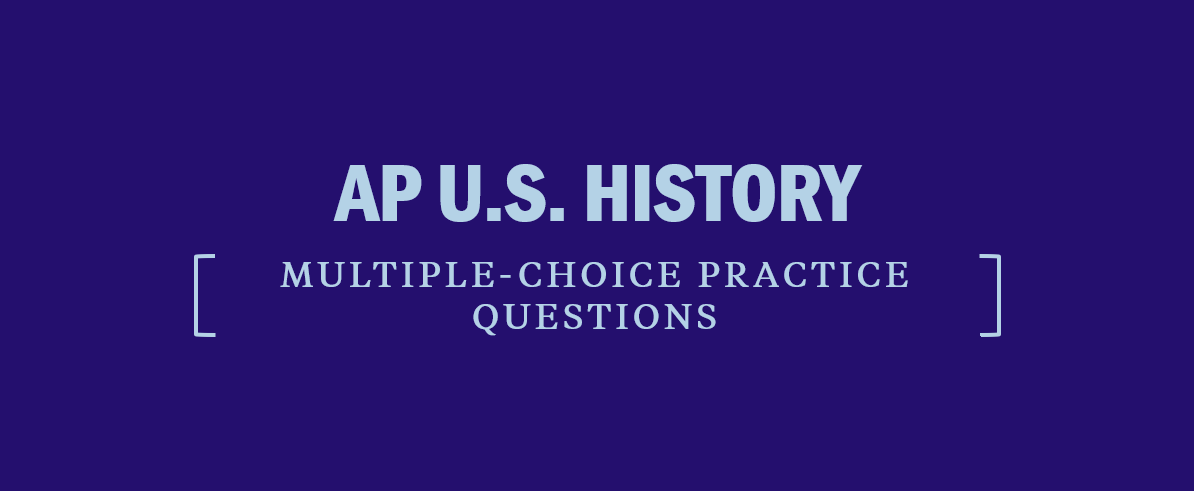AP US History Practice Questions
Test your readiness for the APUSH exam with these free practice questions.
Answer 1
C – Historians have identified Lyndon Johnson’s Great Society as the continuation or attempt at completion of ideas established during the New Deal by the Franklin Roosevelt administration. Thus, (C) is correct. Johnson reportedly found the New Frontier too timid in its proposals, and he instead harkened back to the wide-ranging reforms of the New Deal era. Thus, (A) is incorrect. The Fair Deal, a proposal by President Truman laid out in his 1949 State of the Union address, was a continuation of the New Deal. Most notably, it advocated for universal healthcare. Johnson and Truman were both inspired by the same source, the New Deal. Thus, (B) is incorrect. The Progressive Era, while sharing some ideas of the New Deal, was also greatly concerned with ideas like antitrust legislation, prohibition, eugenics, and weakening party bosses. Johnson’s Great Society did not concern itself with those issues. Thus, (D) is incorrect.
Answer 2
C – Days and weeks after the incident, a propaganda battle was waged between radicals seeking rebellion and loyalists trying to influence opinion back in England; (C) is correct. The engraving above was used to make prints that were circulated in the Boston Gazette. Few citizens of Boston, including loyalist Tories, decided to enlist in any military force in 1770, much less in the British army, which makes (A) incorrect. (B) is incorrect because the Boston Tea Party was a response to the Tea Act of May 1773, not the Boston Massacre of March 1770. (D) is incorrect because, while citizens would eventually know him as a great leader, George Washington’s appointment to lead a new colonial military force did not occur until June 1775.
Answer 3
B – The Great Migration started around 1910. In 1905, Du Bois held a meeting in Niagara Falls to discuss possible forms of protest against racial discrimination and violence. This group, called the Niagara Movement, joined forces with other concerned African Americans and whites to form the National Association for the Advancement of Colored People (NAACP) in 1908, which gained prominence in the 1910s and onward. (B) is correct. Booker T. Washington’s Tuskegee Institute was founded in the 1880s and gained popularity in the 1890s, before the Great Migration had occurred, making (A) incorrect. The Freedman’s Bureau, founded by the federal government in 1865, also pre-dated the Great Migration, making (C) incorrect. The Congress of Racial Equality (CORE) was an African-American civil rights organization that was founded in 1942, after the Great Migration; (D) is also incorrect.
Answer 4
B – Following the Vietnam War, the Iranian Hostage Crisis, and the Soviet invasion of Afghanistan, Ronald Reagan proposed a large military buildup to restore America’s prestige and capabilities. This proposal resulted in a notable increase in defense spending during the 1980s up until the gradual breakup of the Soviet Union. (B) is correct. The breakup of the Soviet Union was partly the result, not the cause, of the budget trend illustrated on the above chart . Thus, (A) is incorrect. The savings and loan crisis did not significantly affect the increases in defense spending, as the U.S. national debt increased substantially during the Reagan administration to sup-port this military buildup while simultaneously cutting taxes. Therefore, (C) is incorrect. The Gulf War did not occur until 1990–1991, a decade after this trend began, making (D) incorrect.
Answer 5
A – As American capitalism developed, debates occurred over the role of government in the economy and the proper amount of government intervention necessary to limit the worst abuses of capitalism; (A) is correct. While the majority of garment workers who died in the Triangle Shirtwaist fire were women, the resulting laws affected working conditions of both genders, making (B) incorrect. Though this fire was one of the deadliest industrial accidents in U.S. history, the government became increasingly responsible for protecting urban workers, eliminating (C). Instead of increasing the protection or interests of consumers, the fire led to increased protection of workers; (D) is incorrect.





